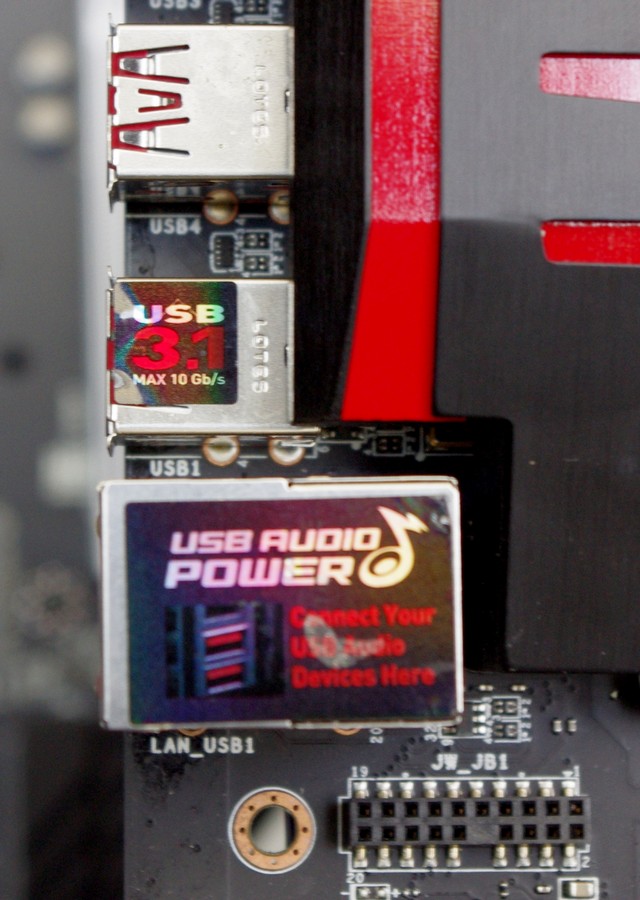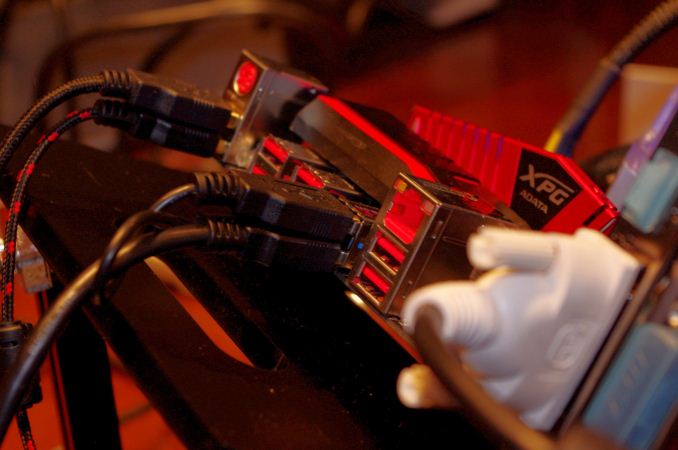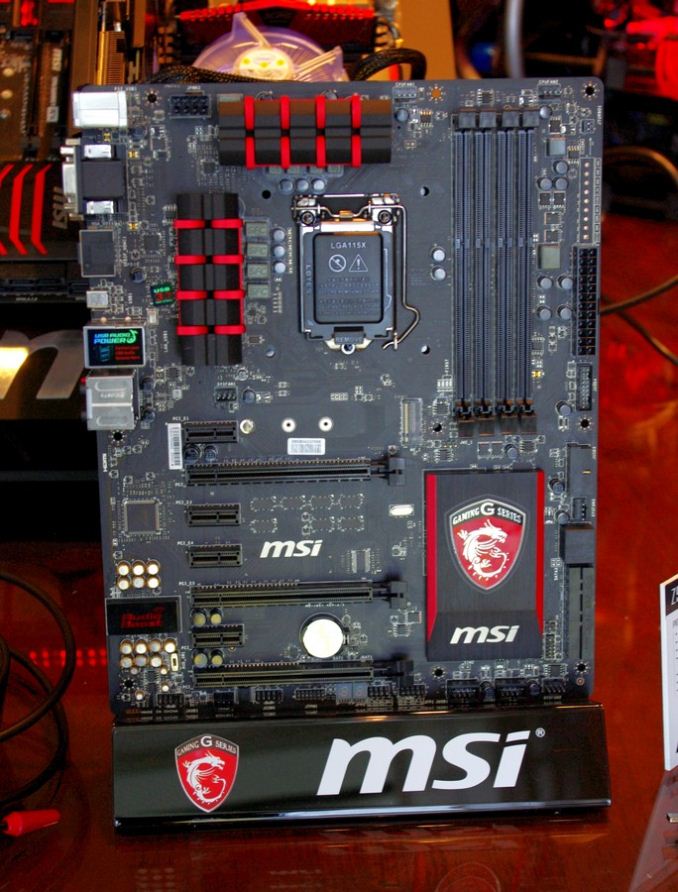MSI Goes USB 3.1 at CES 2015: The MSI Component Suite Tour
by Ian Cutress on January 12, 2015 2:00 PM EST
Back at Computex we reported that MSI was showing a potential mock-up of USB 3.1 on one of their motherboards. Fast forward a few months and this is slowly becoming a reality, with working silicon and demos on hand, almost ready to ship. USB 3.1 is set to be used in two different standards: the USB Type-A connector that we are all familiar with (and get frustrated when it never goes in first time) and the Type-C reversible connector that is being pushed and marketed as the next USB connector standard. MSI had motherboards showing both on display.
The working model for USB 3.1 that MSI had at the suite involved the Type-A connectors connected to a special 3.1-to-RAID device which was kept under wraps due to NDA or other reasons. There will be a number of USB 3.1 controllers available for motherboard manufacturers to use until it comes part of the chipset, but MSI told us that companies like ASMedia and VIA are the usual sources for this and both are being considered right now. The controller being used by MSI gave two ports and uses two PCIe 2.0 lanes, meaning that the total bandwidth between the two ports would be 10 Gbps. For this demo these two ports were being used as one for data and one to power the device in the box.
A word about the power – while the USB 3.1 specifications should allow 100W in quick charge mode, it is up to the manufacturer to support this. Having 100W going through the motherboard at the rear panel will need to design the extra circuitry in order to provide that power, which has an associated PCB area and monetary cost. At this point in time, I do not see the maximum power delivery option going to be on many (if any) solutions both in desktop and notebooks unless it is a super high end product. It will more likely end up with the plug-in-the-wall to USB adapters that are supplied with notebooks.
Nevertheless, the USB 3.1 setup which we were told used two 128GB Intel 530 SSDs in RAID-0 showed performance better than that of a single SATA 6 Gbps port. As shown in the image above, 600+ MB/s is possible with the right hardware on the other end, which leads to another potential issue with USB 3.1. The devices that can take advantage of USB 3.1 data transfer are most likely going to be few and far between, even for 2015. Those that will exist will be expensive, and the market will not have matured enough to work out all the kinks. This puts motherboard manufacturers in an odd position, because USB 3.1 is an interesting feature to work with, but at the minute it is not a must-have feature. On the plus side, it probably has more relevance than SATA Express at this point which is on a lot of motherboards, but the chipset support is part of that. When USB 3.1 is added to the chipset (2016?), then it will become ubiquitous I am sure.
The other side of the USB 3.1 equation from MSI was the Type-C connector. MSI was showing off a board using the reversible connector that should end the bane of users fiddling at the back of computers. MSI showed the board and a Type-C to Type-A cable, although not the two in action as they are still working the details out. The cable will be interesting, depending on how freely they will be available in the market and if users will happily move to them. The question then becomes when or if devices transition to Type-C for power and data, and away from Micro-USB for smartphones/tablets or Type-B for attached storage.
One interesting point that MSI provided with the Type-C connector was the issue of port longevity. The port itself is good for over 10k inserts and removals (and probably more as the underlying engineering might change), but the weakpoint will be at the end of the metal connector that actually is used in the male/female part. With enough torque on the connector, making the cable bend one way or another, the Type-C implementation might break either on the motherboard or the cable itself. MSI is looking into ways of reducing this, such as surround shielding for the port or thicker wall linings, but it raises a valid concern moving forward especially on the smartphone/tablet side of the equation where this issue comes up now and again.
With regards the Type-A connectors, MSI should be releasing a motherboard on this within the next few weeks, the X99A Gaming 9 ACK, while the Type-C model, the Z97A Gaming 6, will be further down the road. Depending if we get the sufficient hardware to test it, it will be an interesting angle for MSI’s product line.















32 Comments
View All Comments
jjj - Monday, January 12, 2015 - link
The Nokia n1 tablet might just be the first device shipping (it is shipping) with Type-C.On the chip side, as far as i know Cypress was the first to have one.
jjj - Monday, January 12, 2015 - link
oups, it appears that the Nokia is using the reversible connector but on USB2 lol.kpb321 - Monday, January 12, 2015 - link
I expect that to be the case for most phones/tablets. The USB C connector support USB 3 and 3.1 speeds but is actually a separate thing and doesn't require USB3 support. It can be used simply as a new connector for usb2 to replace Micro USB with something that is reversible. USB3 support has been pretty limited on phones and tables and the few Samsung phones I've read about that had USB3 also had issues with it that caused them to default to having it off and requiring you to manually enable it when you wanted to use it.fokka - Tuesday, January 13, 2015 - link
type-c limited to usb2 speeds still makes sense though, since you don't really need the full 10gbit and 100w usb3.1 tops out at. 2a/10w would be enough to charge it, transfer rates would be capped at 30mbyte/s though, but it's not that you would get that much more with usb3.1 anyways.BubbaJoe TBoneMalone - Monday, January 12, 2015 - link
Whatever happened to the ASUS USB 3.1 motherboards codenamed Shadowcat and Quicksilver from Computex 2014?http://rog.asus.com/325712014/asus-gaming-motherbo...
7amood - Tuesday, January 13, 2015 - link
There is no type-C on thoseJBVertexx - Monday, January 12, 2015 - link
Regarding the power issue, seems like they should be able to add a PCIE power connection into the back-panel to provide the power, rather than trying to wire the extra 100W through the motherboard PCB. Most builds have extra PCIE power connectors that can be utilized to provide the extra power.DanNeely - Monday, January 12, 2015 - link
The 100W option requires extra hardware on the Mobo. It's 5A @ 20V; meaning that an extra set of power circuitry is needed to create a 20V source on the mobo to output it.Gigaplex - Monday, January 12, 2015 - link
You can do that on a little daughterboard on the back panel, it doesn't have to route through the main part of the motherboard.DanNeely - Tuesday, January 13, 2015 - link
...and then a second one to somewhere along the front/bottom edge for headers connecting front panel hookups. No, if it's going to happen it needs to be integrated into the mobo somehow.And while personally, I lean towards hoping the 20V bit dies along with the rest of the USB groups one cable to bind them fantasies. (If you've got dozens of mutually incompatible not-USB streams being sent over the same type of cable, it's no longer any more universal than RS-232 was 25 years ago.)
If it does happen, my hope is that it finally prods the ATX people into replacing the 24 pin legacy connector with something that ditches the huge number of 3.3/5V wires that a 90's era PC (where everything ran on 3.3 or 5V) needed with a somewhat smaller connector that in addition to giving a bit of 20V has enough 12v that low power systems could dispense with the extra 4pin connector as well.